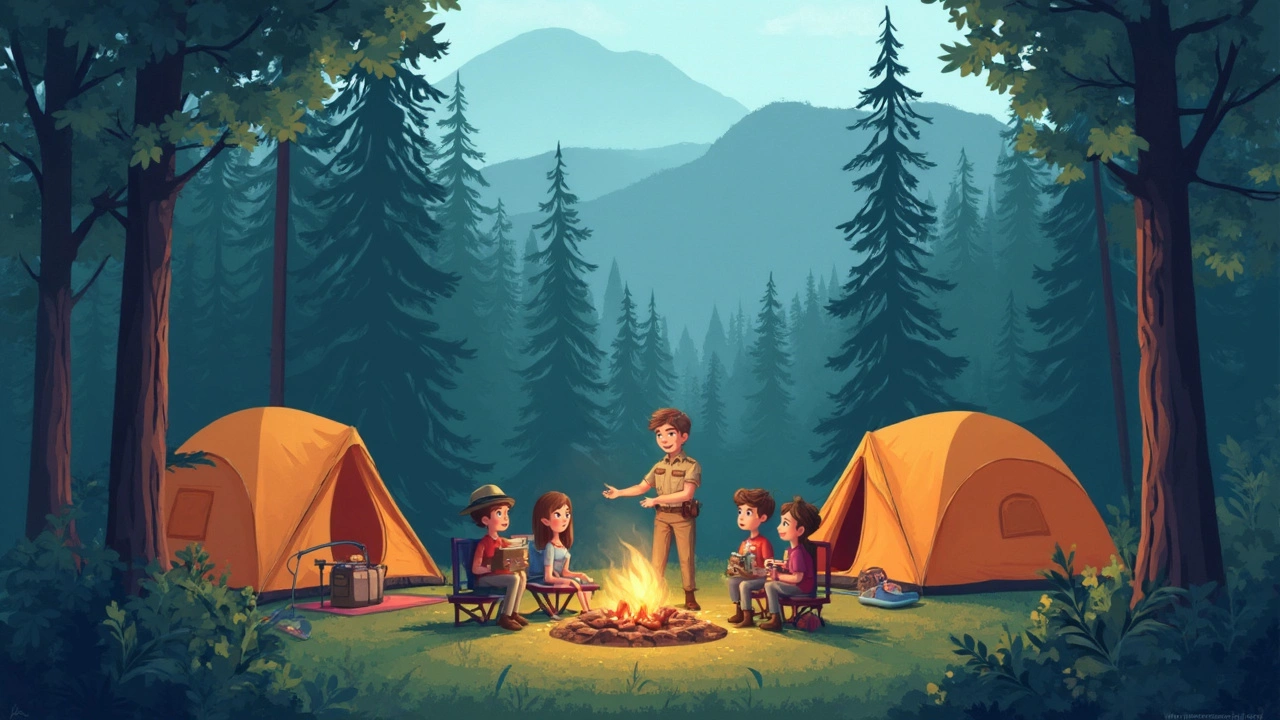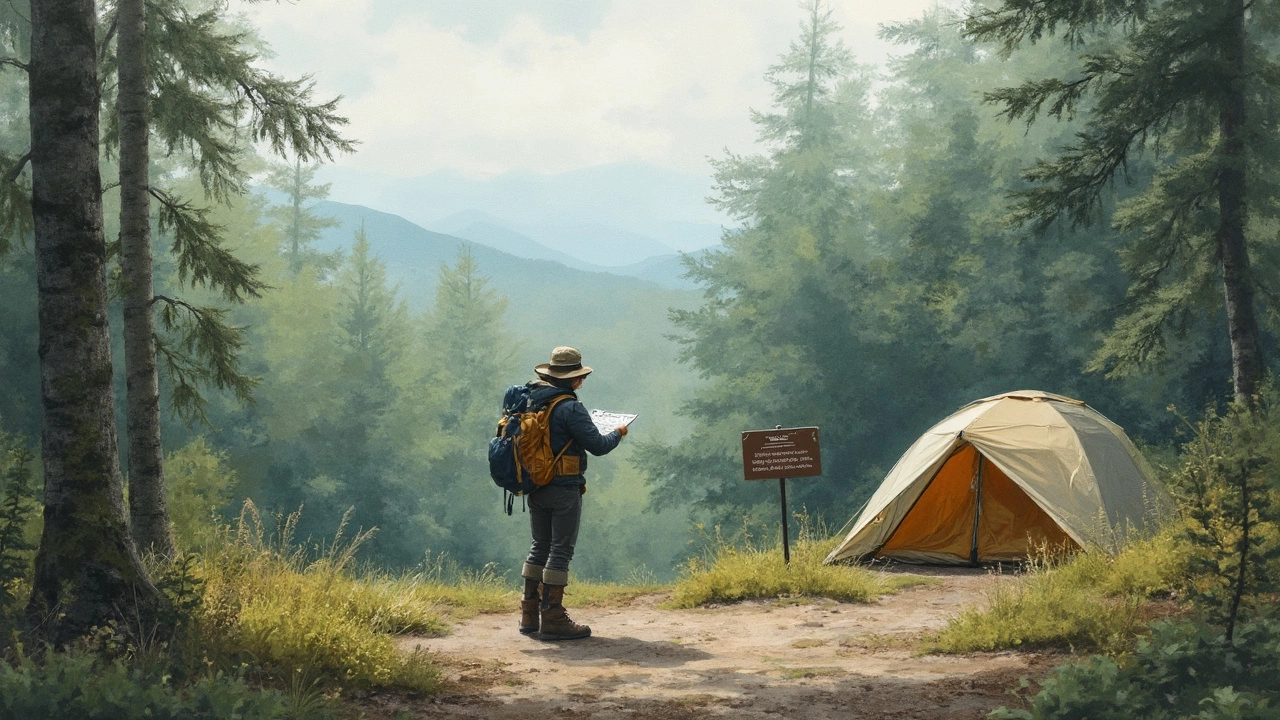Camping in Virginia’s National Forests: Rules, Tips, and What You Need to Know
 Jun, 29 2025
Jun, 29 2025
I’ll never forget the first night I camped in the George Washington National Forest. I thought coyotes were howling in the distance (they weren’t), and I kept one eye open, just in case. But lying there under a canopy of oaks, feeling far away from deadlines and the digital grind, I realized how wild and free you can feel on protected land in Virginia. If you’re itching for the same kind of escape, let’s break down exactly what it takes to camp on National Forest land in the Old Dominion—and, yeah, you definitely can do it.
What Are National Forests in Virginia and Where Can You Find Them?
Virginia is home to two massive swaths of federally-managed forests: George Washington and Jefferson National Forests. Combined, they stretch for about 1.8 million acres, zig-zagging through western and southwestern Virginia, touching West Virginia and a smidge of Kentucky. If you’ve hiked along the Appalachian Trail in Virginia or found a trout stream far off the beaten path, you’ve probably been on National Forest land.
The George Washington National Forest covers the Shenandoah Valley area and reaches as far as the Blue Ridge Mountains. The Jefferson National Forest sprawls further south, bordering Tennessee, and wraps around Blacksburg and Roanoke. Most folks in Virginia or nearby states are no more than a couple of hours away from one of these forests.
These aren’t just stretches of wild land. Scattered throughout are developed campgrounds (with actual bathrooms!), hidden trout-filled creeks, remote trails, old fire towers, rustic cabins, and plenty of roads begging for a long drive with a bag of snacks and a killer playlist. It’s not the same vibe as a state park—here, it’s a bit wilder, and the feeling you’re off the grid is downright addictive.
For folks looking for a quick getaway, both forests offer spots where you can set up a tent close to your car or, if you prefer, hike a few miles in and find your own private patch of woods. The options are endless, which is exactly what makes camping here so special.
Dispersed Camping vs. Developed Campgrounds: What’s the Difference?
Let’s clear this up first: yes, you can definitely camp on most National Forest land in Virginia, but there’s a difference between camping in established campgrounds and what’s called “dispersed camping.”
Developed campgrounds are spots with amenities like picnic tables, fire rings, bathrooms, and sometimes even showers (luxury, right?). Examples include Sherando Lake, Elizabeth Furnace, and Cave Mountain Lake. Here, you’ll usually pay a small fee (think $10-$20 per night), and spots can fill up fast, especially on weekends in summer or peak foliage season.
Dispersed camping means camping outside those official campgrounds. No bathrooms, no fire rings, no one coming by to collect a fee—it’s just you, your tent, and whatever hacking noise the forest makes at midnight. You typically need to be at least 200 feet from streams or lakes, and set up at least 1,000 feet from developed recreation areas or campgrounds. You can stay up to 14 days in the same spot within a 30-day period, which is pretty generous compared to other areas of the country.
There are some exceptions, like special wildlife areas or places with heavy restoration going on. Most ranger districts have a map showing spots where dispersed camping is allowed, and areas where it’s off-limits due to overuse or sensitive habitats. George Washington & Jefferson National Forests have a handy interactive map on their website for pinpointing these zones.
Be aware—no matter where you camp, rules about fires, trash, and respecting wildlife are strictly enforced. Rangers don’t mess around. If you roll in with a party of 20 folks and a truckload of fireworks, someone’s going to come say hi. Quiet enjoyment is the name of the game.

Permits, Fire Restrictions, and Rules You Need to Know
Permits might sound like a hassle, but they’re mostly straightforward in Virginia’s National Forests. For regular dispersed camping, you usually don’t need a permit, unless it’s a group larger than 75 people or you’re hosting a special event. Some popular sites and wilderness areas (especially near the Appalachian Trail) might require a self-issue or online registration, especially during busy seasons. If you’re heading out during hunting season, throw some blaze orange in your pack—you’ll thank me when you see those hunters’ eyes lighting up at sunrise.
Fires are a big deal. The Forest Service regularly posts fire bans when it’s dry, especially in late summer and early fall. Even if there’s no ban, you should use existing fire rings whenever possible, keep your fires small, and never leave a fire unattended. Yes, Smokey Bear is still right about the whole ‘only you can prevent wildfires’ mantra. “Improperly extinguished campfires are the #1 source of wildfires in Virginia’s national forests,” according to the Forest Supervisor’s Office, as cited by a local newspaper last September.
Trash—just pack everything out. Even food scraps. I once watched a bear nose through ramen packets left by careless teenagers. Don’t be that person. Bear canisters aren’t required, but they’re pretty smart if you’re more than a mile from your car. Black bears are common visitors in these woods; they’re more curious than dangerous, but a breakfast bar left in your tent will test their manners.
You also want to respect quiet hours, usually posted at developed campgrounds from 10 PM to 6 AM. For dispersed camping, it’s about using common sense. Don’t run generators late into the night, don’t blast music, and keep headlights out of others’ tents. People come out here to chill, not to relive a frat party.
Lillian often jokes that the real challenge of National Forest camping is navigating all the rules, but the truth is they’re simple once you know them. Each forest’s website posts up-to-date info on fire bans, trail closures, and aquatics advisories—worth a five-minute check before you drive out.
Best Spots and Hidden Gems for Camping in Virginia’s National Forests
If you want a spot that doesn’t feel like a parking lot, check out Ramsey’s Draft Wilderness Area. There are no reserved sites—just riverside stretches where the water sings you to sleep. Head to Big Schloss or the James River Face Wilderness for epic vistas if you don’t mind carrying your stuff uphill. Hopkins Mountain is underrated, and you might have the whole place to yourself midweek.
If you want campgrounds with flush toilets and picnic tables (hey, nothing wrong with that) try Sherando Lake—they call it the "jewel of the Blue Ridge" for a reason. Elizabeth Furnace is closer to DC and gets lively in summer, but it’s great in spring and fall when crowds thin out. For car camping with epic sunsets, head to Paddy Knob, right on the West Virginia border.
Check the table below for a few popular options, with key features:
| Campground/Area | Type | Features | Notes |
|---|---|---|---|
| Sherando Lake | Developed | Flush toilets, lake swimming, sites with fire rings | Reservations recommended |
| Ramsey’s Draft Wilderness | Dispersed | Streams, hiking trails | No facilities |
| Paddy Knob | Dispersed | Mountain views | No water or restrooms |
| Elizabeth Furnace | Developed | Showers, fishing | Busy on weekends |
| Mount Pleasant | Dispersed | Scenic vistas, solitude | Steep trails |
Most of these are available on a first-come, first-served basis unless otherwise mentioned. Some have reservation systems especially during peak season. Always have a backup plan—a spot might be full, or a road could be washed out after a big thunderstorm.

Packing Tips, Safety, and Common Mistakes When Camping in National Forests
Packing for National Forest camping in Virginia is a little different from going to a local state park. The basics: sturdy tent, ground pad, and a sleeping bag good for temps at least 10 degrees lower than you think you’ll need (mountains get chilly even in July). Bring a water filter or purification tablets—some campgrounds have potable water, but many dispersed sites don’t, and nobody likes boiling muddy creek water for coffee.
Bug spray and a good headlamp are essential. Ticks are part of life in Virginia, with Lyme disease still a real concern. Give yourself a check every night and don’t skip the DEET. If you bring food, pack it in sealed tubs or hang it from a tree away from your sleeping spot. Raccoons are cunning little bandits, and black bears can’t resist a snack.
GPS and paper maps are smart. Cell coverage drops out fast once you leave main roads. At least one person in your group should know basic map reading, or at least how to use Google Maps offline. Don’t count on a ranger being nearby—these woods get real empty real fast.
Avoid rookie mistakes like setting up right on a trail or too close to water sources. Those flat-looking areas sometimes turn into shallow streams if it pours overnight. And if you hear thunder, get off ridgelines—storms roll in fast, and the trees don’t offer real protection from lightning.
Want a pro tip? Stick a roll of duct tape in your pack. It’s fixed poles, shoes, even my car’s bumper after a run-in with a rock. I’ve seen duct tape patch everything short of a broken heart.
If you’re heading out solo, tell someone where you’re going and when you’ll be back. The rangers will mount a search if you don’t show up, but it’s a whole lot easier if someone has an idea of your route. Group camping is generally safer, but solo trips can be magical when you're craving headspace.
The National Forest Service states on their official FAQ: "Dispersed camping is allowed in most areas, provided visitors pack out all waste and follow existing regulations to protect natural resources."
The best trips are the ones where you’re prepared but still open to adventure. You might stumble on a swimming hole or watch a sky full of stars you never saw from your driveway. And you won’t find that on a reservation system—it’s all out there, waiting, in Virginia’s National Forests.